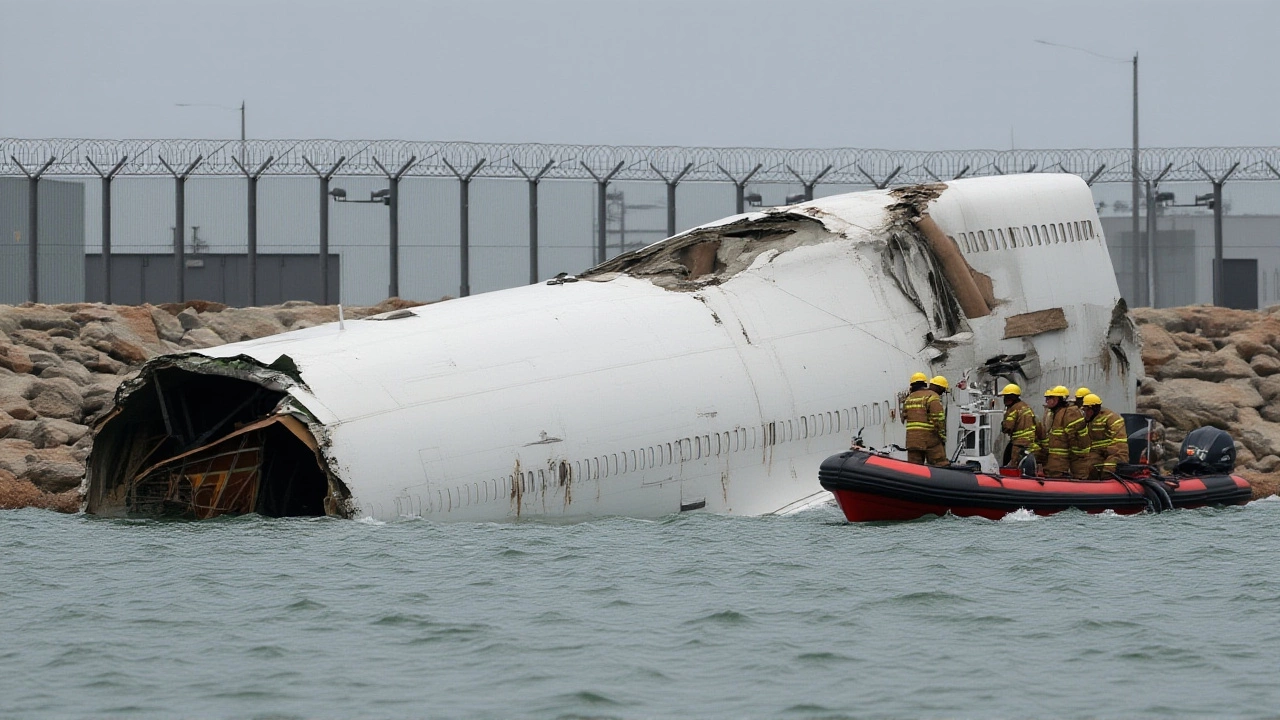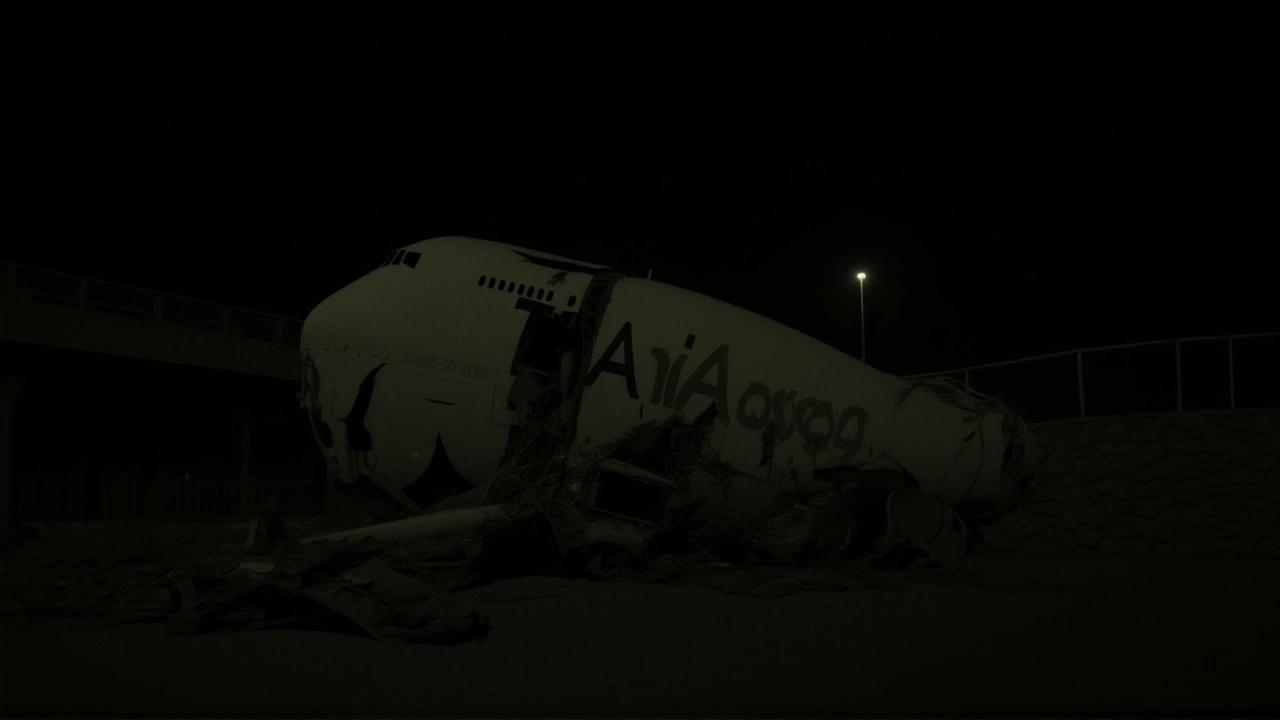When Emirates SkyCargo’s Boeing 777‑200F freighter (flight EK964) slid off runway 07L at Hong Kong International Airport on 20 October 2025, it sparked a chain reaction that left two crew members dead and halted one of the world’s busiest cargo hubs.
Background: Hong Kong’s Cargo Hub and the Flight
The airport, perched on Chek Lap Kok island, handled a record 4.2 million tonnes of cargo in 2024, making it the eighth‑busiest cargo airport globally. Flight EK964Hong Kong International Airport was a routine Dubai‑to‑Hong Kong cargo run, carrying about 98.7 metric tons of pharmaceuticals and electronics.
The aircraft, registration A6‑EMF, is a 2010‑manufactured Boeing 777‑200F (serial 35387) with 25,342 flight hours. It had just completed a C‑check in Dubai on 15 June 2025, so mechanically it was deemed airworthy.
Incident Details: What Went Wrong?
At roughly 15:00 HKT (07:00 UTC), heavy rain battered the runway, wind gusts hit 35 knots, and visibility dropped to 1,200 metres. Captain Rajesh Kumar, a 45‑year‑old Indian pilot with 12,850 flight hours (7,200 on the 777), was at the controls. Sitting beside him was First Officer Arjun Patel, 38, with 8,420 hours total.
According to senior accident investigator Ms. Lee Wai‑ling of the Hong Kong Civil Aviation Department (HKCAD), radar data showed the plane touched down about 1,200 metres beyond the threshold at 142 knots—well above the recommended 100‑120 knots for wet conditions. The aircraft overshot the runway by roughly 300 metres before veering left into the sea, where the fuselage settled in eight metres of water at coordinates 22°18'27.0"N 113°54'38.0"E.
The impact was catastrophic for the crew. Both Captain Rajesh Kumar and First Officer Arjun Patel were pronounced dead at the scene. Emirates confirmed their identities and expressed deep condolences.
Immediate Response and Investigation
Within minutes, the airport fire service and marine rescue units were on scene. Runway 07L was closed indefinitely, prompting the diversion of 37 cargo flights to Guangzhou’s Baiyun Airport and Shenzhen’s Bao’an Airport. The Hong Kong Airport Authority (HKAA) estimated the diversion cost at HK$12.8 million (US$1.65 million) per hour.
At 19:30 HKT, HKCAD Director Mr. Wong Po‑choi announced that the Aircraft Accident Investigation Authority (AAIA) of the United Arab Emirates had been notified under Annex 13 of the Chicago Convention. A 12‑member UAE team arrived on Cathay Pacific flight CX632 at 10:15 HKT on 21 October 2025.
Meanwhile, Boeing pledged technical assistance. Vice President of Safety and Mission Assurance Mike Fleming said Boeing advisors would support the investigation as needed.
Impact on Airport Operations and the Wider Cargo Network
Runway 07L handles over 70 percent of the airport’s cargo traffic. Its closure forced airlines to re‑route flights, adding fuel burn and crew duty‑time complications. Freight forwarders reported delayed shipments of life‑saving medicines, sparking concerns among hospitals in mainland China.
Economists estimate that each hour of downtime costs the Hong Kong logistics sector roughly HK$12.8 million. Over a 12‑hour window on 20 October, the total loss could top HK$150 million (US$19 million).
The incident also revived scrutiny of Hong Kong’s runway safety procedures. Historically, the airport has seen three similar excursions: a Cathay Pacific 747‑8F in February 2020, and UPS cargo aircraft in 2018 and 2022, all without fatalities.

Future Outlook: Salvage, Legal, and Safety Measures
Salvage crews from the Hong Kong Marine Department plan to raise the partially submerged nose section at first light on 21 October. Divers will also inspect the fuselage for hazardous cargo remnants.
Legal experts anticipate insurance claims soaring. Emirates’ cargo insurance covers hull loss, but families of the crew will likely seek compensation through the UAE’s civil aviation liability framework.
Looking ahead, the HKCAD has pledged a comprehensive safety review. Recommendations may include stricter speed limits for wet‑runway landings, enhanced runway‑end safety areas (RESAs), and upgraded drainage systems to mitigate future hydro‑planing risks.
Why This Matters
Beyond the tragic loss of two experienced pilots, the crash underscores the fragility of global supply chains that rely on just‑in‑time air freight. With cargo volumes rebounding after pandemic disruptions, any interruption at a hub like Hong Kong ripples through manufacturers, retailers, and ultimately consumers worldwide.
Frequently Asked Questions
How does this accident affect cargo shipments in East Asia?
With runway 07L closed, about 70 percent of Hong Kong’s cargo capacity is offline, forcing airlines to divert to Guangzhou and Shenzhen. This adds roughly 1‑2 hours of flight time per shipment, pushing delivery windows later and increasing costs for manufacturers and retailers in the region.
What were the main factors that led to the runway excursion?
Preliminary data points to three key elements: excessive touchdown speed (142 knots versus the recommended 100‑120 knots for wet runways), reduced visibility from heavy rain, and a strong cross‑wind component that pushed the aircraft off the centreline shortly after landing.
Who is leading the investigation?
The primary probe is being conducted by the Aircraft Accident Investigation Authority of the United Arab Emirates, working alongside Hong Kong’s Civil Aviation Department, the airport authority, and technical advisors from Boeing and the U.S. NTSB.
What compensation will the families of the crew receive?
Emirates has said it will cooperate fully with the UAE’s civil aviation liability regime. Typically, families receive compensation covering loss of earnings, dependents’ support, and additional statutory payouts, but the exact figures will be determined after the investigation concludes.
Will runway 07L reopen soon?
The runway will remain closed until a thorough safety assessment is completed. Engineers need to inspect the pavement, remove debris, and possibly reinforce the runway end. Early estimates suggest a minimum of several days, but the timeline could extend if structural repairs are required.
